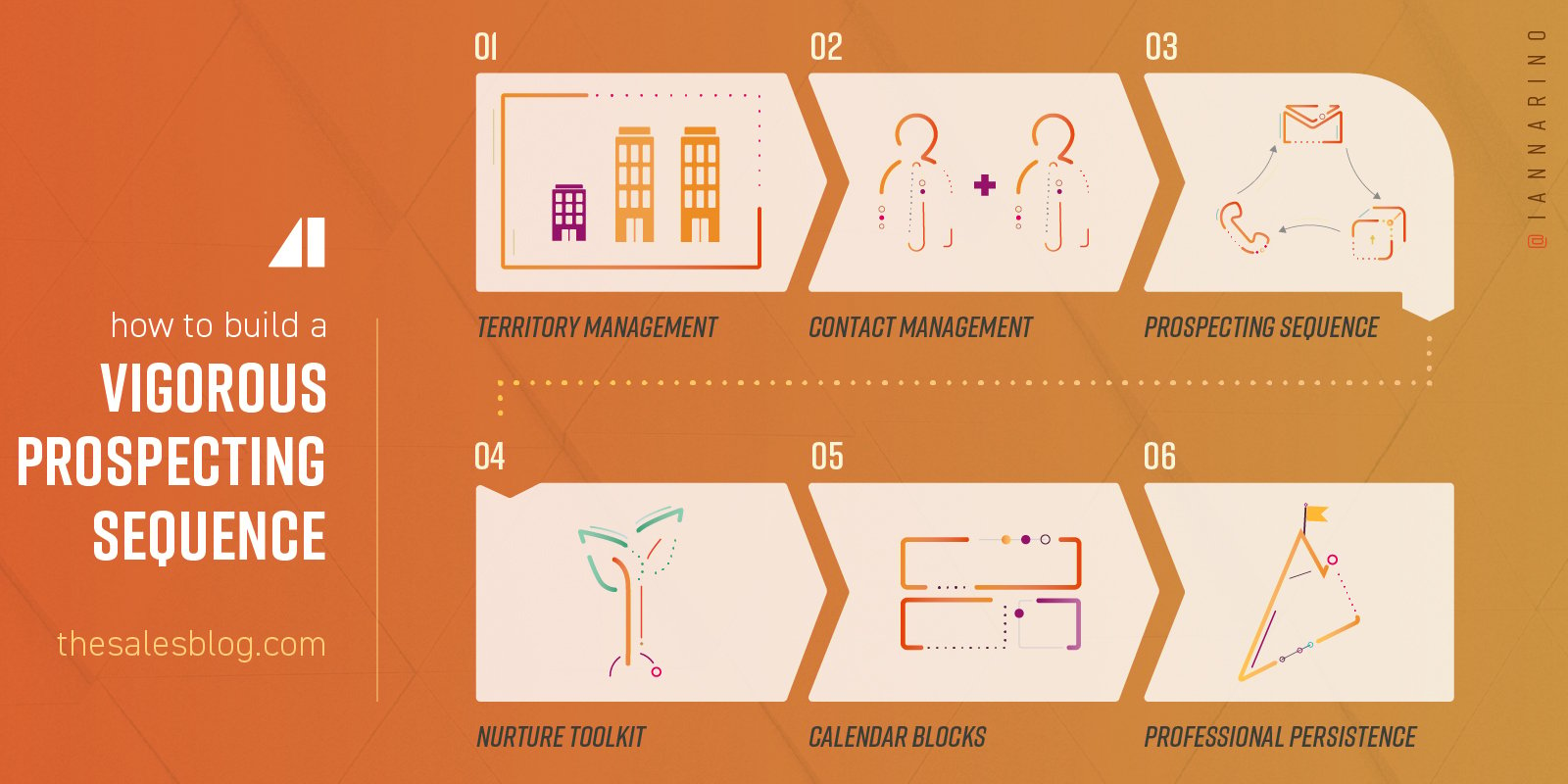The Gist:
- Prospecting effectively requires more structure than sporadic phone calls.
- A more complete view of prospecting starts with a territory plan and a contact plan.
- Success requires both insights and a prospecting sequence that helps you acquire meetings.
Prospecting is a set of activities used to acquire a meeting with a prospective client. Because those activities mostly entail making phone calls and sending emails, it might not seem like you need a prospecting plan. After all, one day you might make dozens of attempts to reach a prospect with no success, while the next day your first four attempts may yield three new appointments.
Looking at prospecting only as an activity is not only incomplete but it can and will harm your results. Widening the aperture to provide a more complete view of prospecting reveals the need for a prospecting plan, both in terms of territory and contacts.

Territory Management
The starting point for an effective prospecting plan, one that ensures you get meetings with the decision-makers and stakeholders inside your prospective clients’ companies, begins with a territory and account plan.
First, identify all of the major prospects in your territory, starting with the companies that you know for certain buy what you sell. The most valuable clients in most territories will already have a supplier, so you’ll need to displace your competitor. Once you have a list of the companies that are known buyers, you can evaluate the other companies that you suspect might buy what you sell—and would value the better outcomes you help your clients generate.
The time is takes to do this work is returned to you many times over by allowing you to organize your efforts. (And while you’re at it, you might also map out the best coffee shops in your territory, adding another strategy to improve your overall efficiency.)
Contact Management
Once you have a map of your territory, identify the contacts at each prospective client and acquire their contact information. You want each contact’s phone number, email address, physical office address, and LinkedIn URL. Put all that information in your CRM, so you can query the information and build lists, something that will be useful when you start prospecting.
The best place to start this work is by figuring out which job roles normally cover decisions about the outcomes that you sell, something you might call “the CEO of the Problem,” to you can target the person responsible for making decisions in your category. Even though different companies use different job titles, starting with the most likely titles will at least get you closer to the decision-makers.
Again, save your brain for thinking: use your CRM to remember and manage all this information. The fact that you still have business cards in your car’s console and little scraps of paper with leads that you haven’t yet called means your current system isn’t particularly good.
Building Insights
The first meeting with a stakeholder at a prospective client is a chance to explore change. Your responsibility in that meeting is to help your prospective client understand why they might need to change, using your insights and your experience to create value by providing them a higher-resolution lens, one that provides a new perspective.
You are an educator. As a consultative salesperson, you have to know more than your client when it comes to improving their results, including why, when, and how they need to change to improve their business. Your insights are the key variable in the value you create for your prospective clients, and the foundation of their preference to buy from you.
By organizing your insights, you are prepared to help your client by compelling them to change and helping them through that process. Without insights you lack a modern sales approach, so you’ll find it incredibly difficult to compel change or differentiate yourself.
Your Prospecting Sequence
Prospecting is more than just a phone call, even though your prospecting plan should always take a “phone first” approach. Your prospecting plan should be a thoughtful series of communications that takes advantage of all the mediums available to you. It should also position you as a value creator and a potential strategic partner.
A good and effective prospecting sequence will include phone calls, voicemail, email, video messaging, text messages, traditional mail, LinkedIn, and, in some cases, walking in the client’s front door and asking for them directly. It can take some time to dial-in the messaging and the actual sequence. The best way to build a prospecting sequence is to start with something and make adjustments as you pursue more clients.
There is no value in calling a client once, only to ignore them for the next ninety days. Your prospecting plan and your sequences form a pursuit plan, which requires a complementary plan to nurture relationships over time. If you teach your client that you’ll go away when they ignore you, you reduce your chances of getting a meeting. Make sure they know you are seriously pursuing them, stopping short of a restraining order.
A Nurture Toolkit
Not every communication with a client needs to be a request for a meeting. Instead, we’ll follow Covey’s example, treating relationships like a bank account into which we make deposits. You can think of these interactions as “no ask” communications, ones where you give value without trying to claim value.
No-ask communications should be based on the insights that you believe will serve your prospective client, proving that you are a value creator and a potential resource, while also keeping you alive in your prospective client’s mind. You can start sharpening your client’s view by ensuring they see the content that provides them context and perspective.
Here is a list of fourteen tools you can use to nurture relationships with your contacts.
Calendar Blocks
You might have expected to see calendar blocks right at the top of this post, but the work you do before you get to calendar blocks increases both your efficiency and your effectiveness. Once you’ve done the work of analyzing your territory, identifying the contacts, developing your insights, building a prospecting sequence, and identifying the nurture tools that shape the lens through which your client views their business, you can simply execute the sequence.
There will be no end of changes in your territory, with companies coming and going, contacts leaving for other opportunities, and new opportunities being pursued by the companies you are calling on. Because you have a plan and a good map, you can account for these changes in real time, updating your plan accordingly.
Professional Persistence
Doing ninety minutes of prospecting a day is not only a good plan—it’s a better plan than deluding yourself that you’ll spend one eight-hour day a week on the phone. Even if you kept that promise, it wouldn’t be very effective.
The reason you need a prospecting plan is that it allows you to be professionally persistent over time. A sporadic approach will produce equally sporadic results. The self-discipline necessary to be consistent over time is what separates high performers from those who struggle. Your prospecting plan is how you play—and win—the long game of B2B sales.
Do Good Work
- Map your territory by identifying every known user of whatever it is that you sell.
- Identify all the factors and trends that should be compelling them to change.
- Block ninety minutes a day to execute your prospecting sequence and nurture your dream clients.

Get the Free eBook!
Want to master cold calling? Download my free eBook!
Many would have you believe that cold calling is dead, but the successful have no fear of the phone; they use it to outproduce their competitors.
Download Now











Comments